This is the view from the guts of a collectivo: the lumbering, honking, metal beasts of Lima's flowing petro-chemical circulatory system. I'm not sure how well these videos express the absurdity of this kind of driving, but I hope they at least provide a few empirical nuances to my attempts at description.
Sunday, January 30, 2011
Saturday, January 29, 2011
Lunch in the Old City
I caught my breath on the bus long enough to notice as it stuck again in my throat in a jarring, bumping, no-margins what-so-ever glide into older, grander, dingier parts of Lima. The five or so rough lanes of traffic on the wide boulevard were swimming with the old metal busses, starting, stopping, lurching and careening so close to one another that it seemed there must be some kind of mad magic guiding the hands of the drivers and cushioning the hulking rigid bubbles that seemed destined to crumple one another without warning. I had a nervous grin plastered on my face, and my hands polished well-worn holds as I craned my neck to watch close call after close call whoosh by. The boulevard, for all its grandiose scale, was inconsistently covered, with large sections dropping several inches at a time and jostling over archaeological bricks and pavers. Our course led through a landscape which changed from big box retailers and KFC's (both literal, and some other chicken joints which included casinos), to huge parks full of public works and fantastic old buildings, to a dense crumbly center of shored-up, throbbing, antique city.
We stepped out of the bus onto the hot street and were met with a face-full of smells that were initially hard to place. As we walked, it became apparent that the odor was the product of an entire district of printing businesses, all churning out brightly colored posters and pirate media covers. Beyond this area we found the district that we'd been looking for, blocks full of rooms open to the street each with a placard announcing its menu. After this much time spent in transit, we were at a loss to choose a place and we picked our restaurant slowly and poorly.
From the outside most of the places looked the same, and the difference in price was something that only people truly out of whack in terms of budget and exchange rate delirium would have quibbled over, and so, as I recall, we made the unfortunate decision to low-ball it. We ended up with a truly scary spread: glistening lettuce, a goblet of clearish liqud that appeared to have something grainy like the end of a glass of juice, strange fish, sinister-looking seaweed, gristle, bone, repeated helpings of rice-bean slurry and an off-yellow jello.
Our discomfort was further complicated by a conversation with a man who was trying to hard-sell us a lunchtime serenade via the improbable technique of telling us that we lacked the capacity for the true, deep musical expression like that of indigenous people like himself. The man was unpleasant, the food more-so, and yet things were so busy in the hot dark room that we remained at the mercy of this musical extortionist and his pitch, unable to pay our bill. We left abruptly, feeling bad about wasting awful food and worse about being picked on while doing so.
The vibe was not so good, and the crowds in the streets that day were packed-in tightly and eager for sols. We walked in circles briefly before finding the first hostel (closed) and then the second hostel we hoped to investigate. We were ushered into a very old waiting room full of deteriorating antiques and a pleasant funk, then through a pair of locked doors into what all senses was unmistakably a hospital. At three beds to a room, a rate hike, and the promise of a horrible schlep to get our stuff there, we were not impressed and waited to be let out again.
We needed to redeem the old city, at least for the purposes of this first visit, so we kept walking. The square was beautiful, sunny, filled with weird stuff to look at, Saints' identities to debate and little old ladies to talk to.
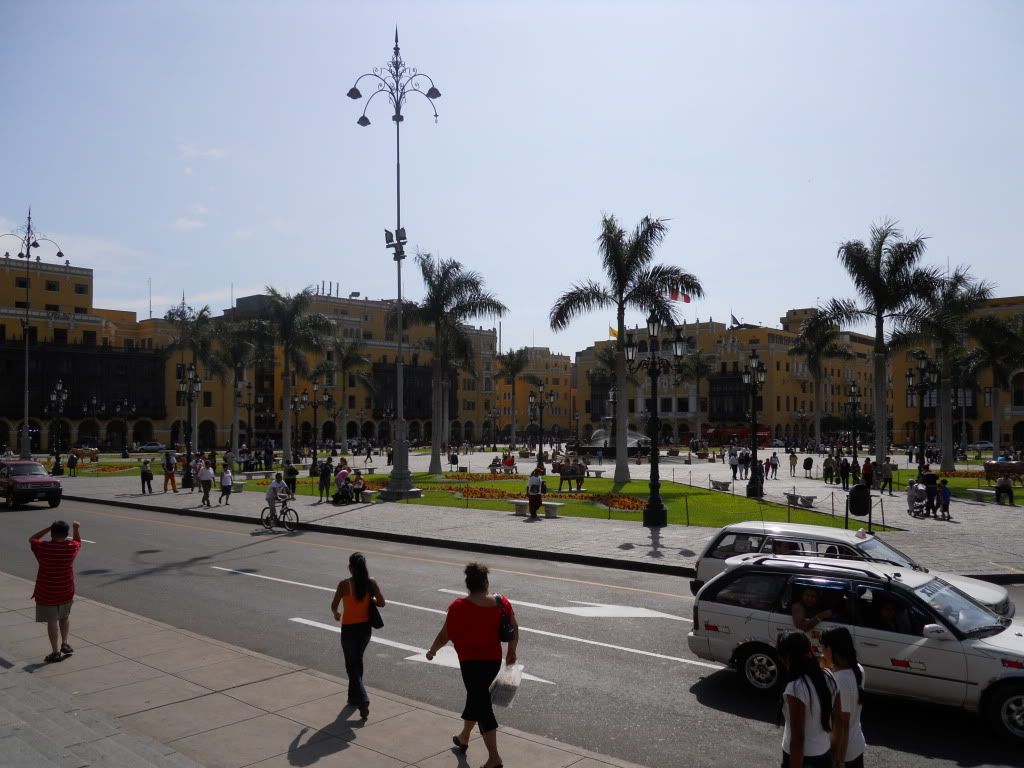

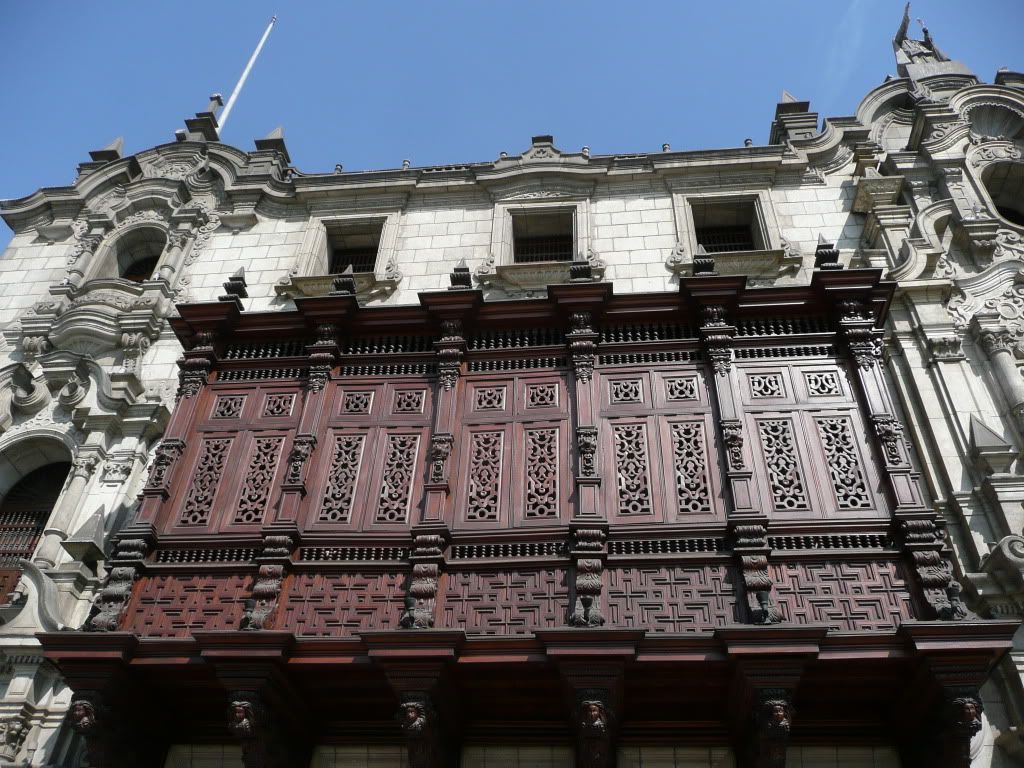
The buildings in this part of Lima, as should now be apparent, are extremely ornate and colorful, and on the other side of the square we turned right and came to a pink building with a glass ceiling full of women trading in collectible objects: coins, bills, photos, all kinds of bits and pieces wrapped in cellophane. I went in to be cool.

After this, we almost turned back, but half a block further we ran into a whole lot of stalls out in the sun. Posters, books, prints, textiles, toy guns, guns on the backs of soldiers strolling pairs of soldiers. Dear reader, if you'll recall them from our video shot in Parque Central, we were once more surrounded by familiar geometric solids protruding from the paved thoroughfare. Off toward what I think was the North, a hillside peppered with colorful boxes was set behind a frothy brown river under a suspension bridge.
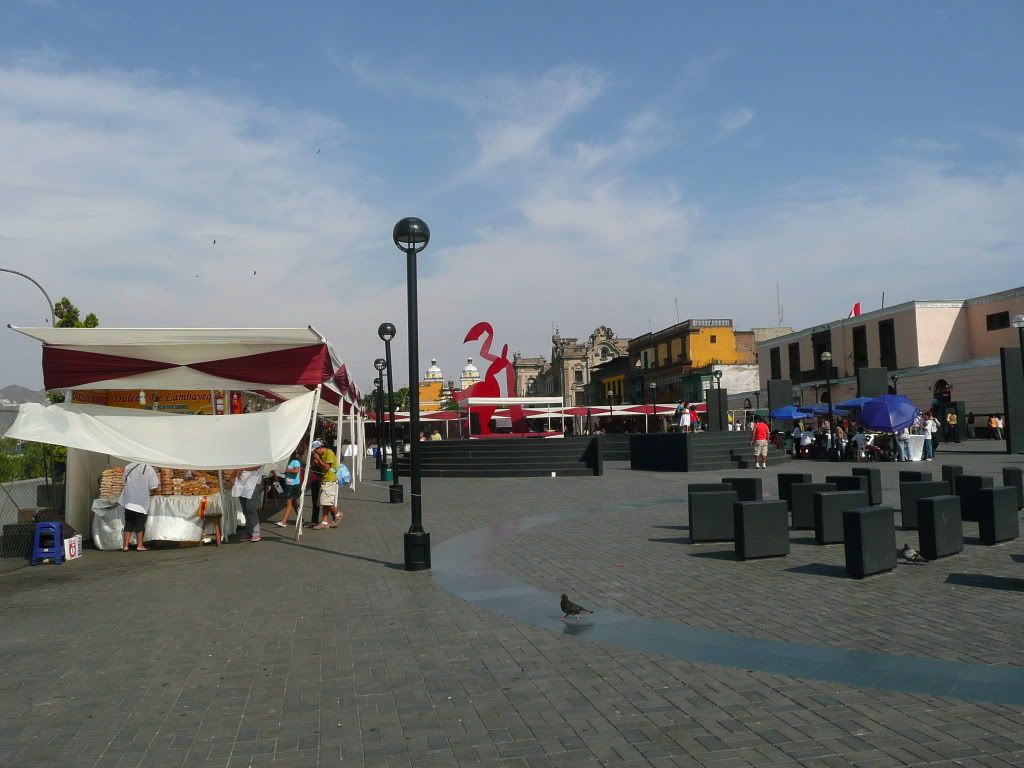
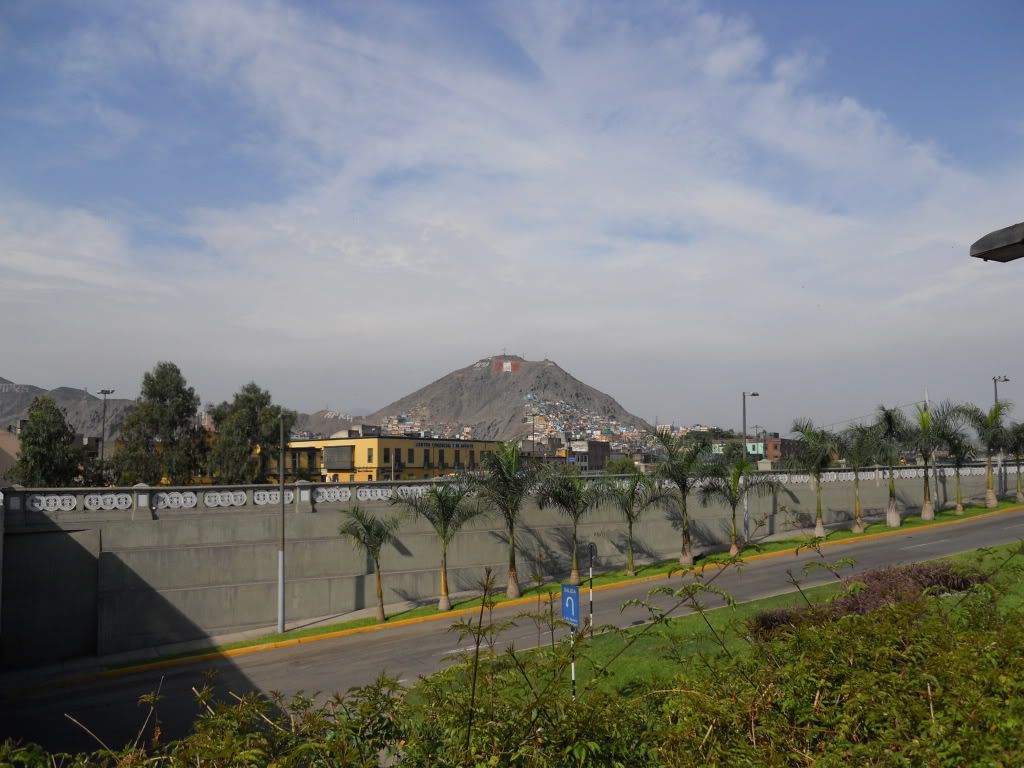
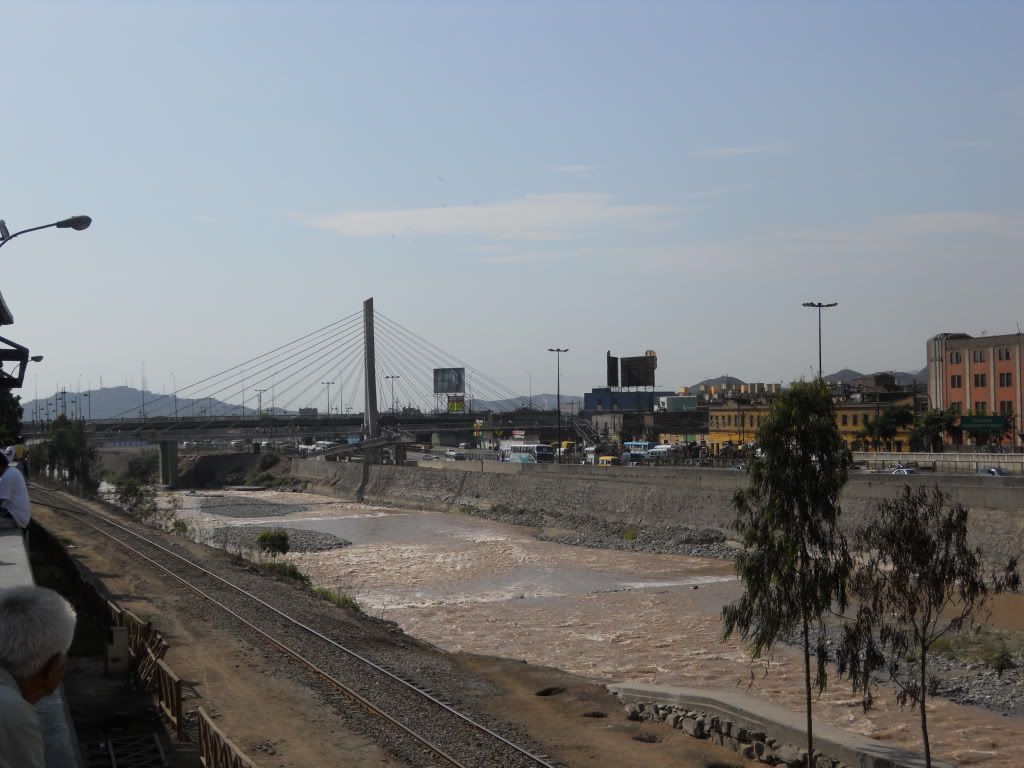
A man with a microphone strung from a small amplifier preached an uncomfortably earnest gospel to no one in particular, and we started to head for shade and cold drinks, when we spotted the food. There, piled in the sun, were heaps of wonderful everything, ceviche, cuy, choclo, a perverse Peruvian smorgasbord! I was still not hungry, in fact still quite unappetized by our unfortunate lunch, Miriam is blessed with the powers of temporary amnesia and instantaneous hunger in situations of obvious deliciousness, and was quickly served up a heaping plate of exquisite.
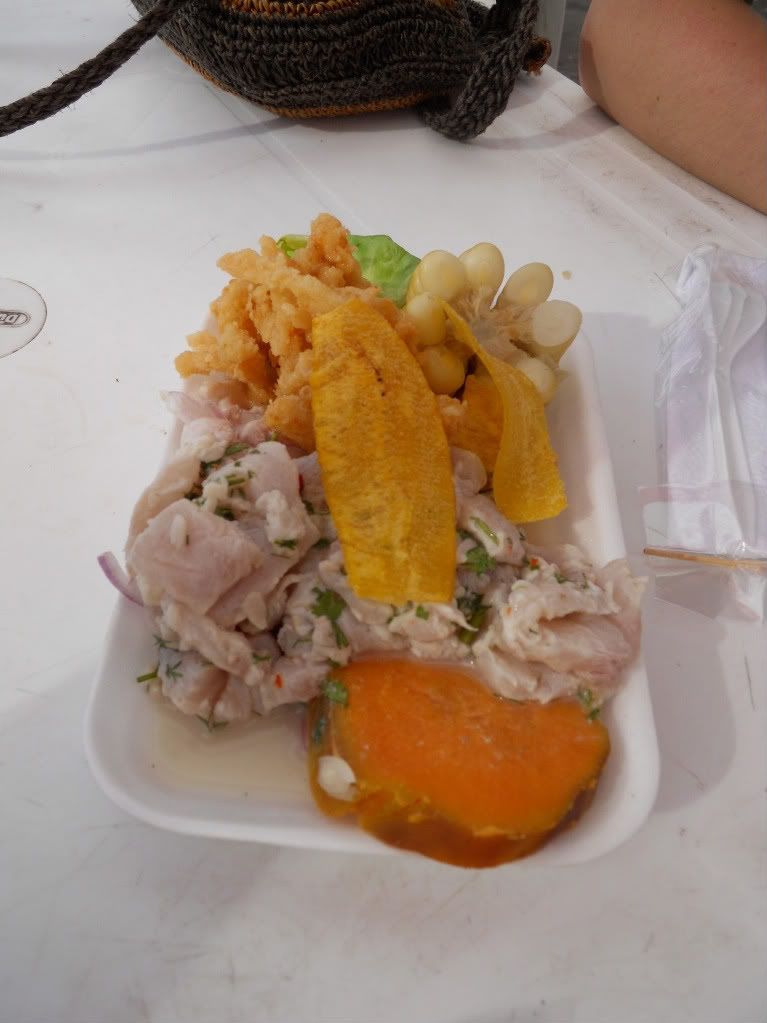
To complement this munching, we were offered the stylings of the saddest mime ever, a young man who's boxed entrapment and briefcase pantomime drew yawns and muffled golf claps from even those in the crowd who seemed to be obvious stooges (relatives). Poof! the ceviche vanished into the mid-afternoon heat, and we resumed our wandering. We adopted a brisk pace back in the general direction of the street that we had come by, stopping to look at gnarled church carvings and full-service dentist/doctor/surgeon/obgyn boutiques for the do-it-yourself type. We were slowed only briefly by a strange, mustachioed fellow wearing a Hawaiian shirt who took up about two minutes chit chatting and only pulled out the ol' "Taxi?" "Weed?" bit after I'd summoned all of my linguistic powers to tell him that we were late and needed to get a move on.
The afternoon was nearly played-out by this point, and we had to make the hostel in time to ask politely if we could re-check-in and avoid having to move in the dark. We caught the bus back and hopped out at the corner of Parque Central...
We stepped out of the bus onto the hot street and were met with a face-full of smells that were initially hard to place. As we walked, it became apparent that the odor was the product of an entire district of printing businesses, all churning out brightly colored posters and pirate media covers. Beyond this area we found the district that we'd been looking for, blocks full of rooms open to the street each with a placard announcing its menu. After this much time spent in transit, we were at a loss to choose a place and we picked our restaurant slowly and poorly.
From the outside most of the places looked the same, and the difference in price was something that only people truly out of whack in terms of budget and exchange rate delirium would have quibbled over, and so, as I recall, we made the unfortunate decision to low-ball it. We ended up with a truly scary spread: glistening lettuce, a goblet of clearish liqud that appeared to have something grainy like the end of a glass of juice, strange fish, sinister-looking seaweed, gristle, bone, repeated helpings of rice-bean slurry and an off-yellow jello.
Our discomfort was further complicated by a conversation with a man who was trying to hard-sell us a lunchtime serenade via the improbable technique of telling us that we lacked the capacity for the true, deep musical expression like that of indigenous people like himself. The man was unpleasant, the food more-so, and yet things were so busy in the hot dark room that we remained at the mercy of this musical extortionist and his pitch, unable to pay our bill. We left abruptly, feeling bad about wasting awful food and worse about being picked on while doing so.
The vibe was not so good, and the crowds in the streets that day were packed-in tightly and eager for sols. We walked in circles briefly before finding the first hostel (closed) and then the second hostel we hoped to investigate. We were ushered into a very old waiting room full of deteriorating antiques and a pleasant funk, then through a pair of locked doors into what all senses was unmistakably a hospital. At three beds to a room, a rate hike, and the promise of a horrible schlep to get our stuff there, we were not impressed and waited to be let out again.
We needed to redeem the old city, at least for the purposes of this first visit, so we kept walking. The square was beautiful, sunny, filled with weird stuff to look at, Saints' identities to debate and little old ladies to talk to.



The buildings in this part of Lima, as should now be apparent, are extremely ornate and colorful, and on the other side of the square we turned right and came to a pink building with a glass ceiling full of women trading in collectible objects: coins, bills, photos, all kinds of bits and pieces wrapped in cellophane. I went in to be cool.

After this, we almost turned back, but half a block further we ran into a whole lot of stalls out in the sun. Posters, books, prints, textiles, toy guns, guns on the backs of soldiers strolling pairs of soldiers. Dear reader, if you'll recall them from our video shot in Parque Central, we were once more surrounded by familiar geometric solids protruding from the paved thoroughfare. Off toward what I think was the North, a hillside peppered with colorful boxes was set behind a frothy brown river under a suspension bridge.



A man with a microphone strung from a small amplifier preached an uncomfortably earnest gospel to no one in particular, and we started to head for shade and cold drinks, when we spotted the food. There, piled in the sun, were heaps of wonderful everything, ceviche, cuy, choclo, a perverse Peruvian smorgasbord! I was still not hungry, in fact still quite unappetized by our unfortunate lunch, Miriam is blessed with the powers of temporary amnesia and instantaneous hunger in situations of obvious deliciousness, and was quickly served up a heaping plate of exquisite.

To complement this munching, we were offered the stylings of the saddest mime ever, a young man who's boxed entrapment and briefcase pantomime drew yawns and muffled golf claps from even those in the crowd who seemed to be obvious stooges (relatives). Poof! the ceviche vanished into the mid-afternoon heat, and we resumed our wandering. We adopted a brisk pace back in the general direction of the street that we had come by, stopping to look at gnarled church carvings and full-service dentist/doctor/surgeon/obgyn boutiques for the do-it-yourself type. We were slowed only briefly by a strange, mustachioed fellow wearing a Hawaiian shirt who took up about two minutes chit chatting and only pulled out the ol' "Taxi?" "Weed?" bit after I'd summoned all of my linguistic powers to tell him that we were late and needed to get a move on.
The afternoon was nearly played-out by this point, and we had to make the hostel in time to ask politely if we could re-check-in and avoid having to move in the dark. We caught the bus back and hopped out at the corner of Parque Central...
Labels:
Cathedral,
Comida,
Excuses,
Lima,
Peru,
South America,
Stop and Drop,
Walking
Friday, January 28, 2011
Later That Day
We got out three maps before leaving the Stop and Drop to explore the old city and wrote down the names of some other hostels to investigate. If you've ever looked at a guidebook on Peru or South America more generally you might already be aware that Lima defies what I had considered widely held cartographic assumptions and expectations. There is no such thing as a map of Lima, rather the reference materials consisted of maps of vague seemingly inconsistent sections, districts, and regions of greater Lima (this should give you some idea what I'm talking about) as it splashes back from the coast and up into the hills.
So we looked at our maps, holding them up next to one another, or flipping pages back and forth to try to construct a cohesive vision of the route, thought about it for a while, stashed our bags in some lockers and headed off on foot. This seemed like something that people could do, even given that we were getting hungry and it was probably 95 degrees.
We walked and talked our way up through a long shady park set between the lanes of a wide divided road. Eventually, we ran out of Miraflores and its consistent and plentiful foliage found ourselves walking along mostly a lot of sunny residential streets interspersed with gigantic crossings, roundabouts and other traffic-shaping devices that seemed all seemed gigantic. We managed to figure out how to traverse a number of these traffic formations without becoming unfortunate road splatter before coming to this point:
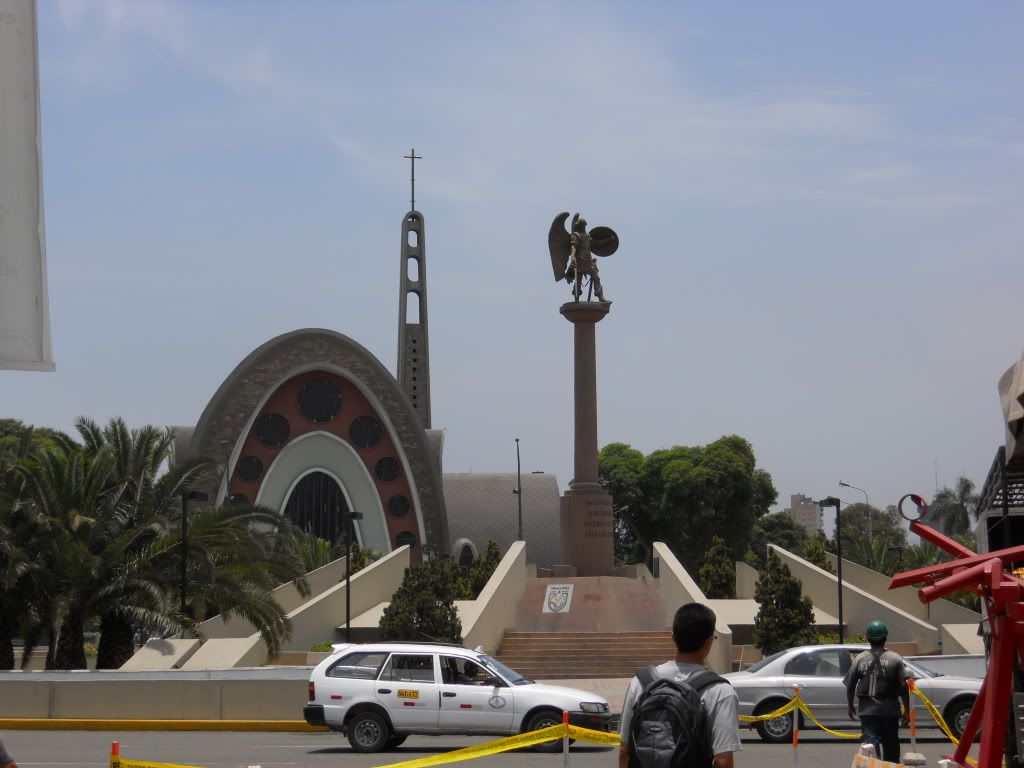
We worked our way around this circus, and, as we did, got to watch a lot of traffic negotiating. We waited at a crosswalk, fantasizing aloud about finding lunch by this point, and watched as a man with a clipboard yelled to all the bus drivers who passed this corner and then received some amount of coin in a can borne by what I guessed was probably a nine year-old boy. Mostly, this system seemed to be tuned to a degree that was remarkable. Words flew back and forth, the kid stood in the gutter and held the can aloft, change was deposited smoothly, and then as we watched the pace of traffic started to pick up. The next bus that yielded at the corner had only a few seconds before the bus driver felt himself inextricably yanked into the flow of traffic. Words were being exchanged, but as the bus lurched past the corner the change was cast hastily into the street. The man with the clipboard quickly assigned blame and meted out punishment to the youth, though it seemed apparent to me that the backhand was redundant, the kid was already looking dejected about his poor performance in the face of this challenging can-handling scenario.
Miriam and I drank some of our warm, metallic water and resumed our walk. As we moved along we brought out our maps again and tried to get some sense for how far we had come. Two of the maps, the ones with tight views of Miraflores and the Old City were completely useless. We had come to a place of dubious importance to even the most intrepid of casual guidebook urban Lima hikers. Presently, I located the big St. Michael roundabout on the map, we estimated our movements to this point as having been approximately 1cm per hour. At this rate we would reach our destination in a matter of hours, not minutes. We started to look around for alternative modes of transportation.
In a city of seven million taxis, the ones that we saw in this part of Lima had that distinctive *Taxi for a Day* look that we now found unappealing both in terms of general threat to life and property and because we didn't want to have to try to feed directions to another taxi driver who knew about as much as we did about where we were and how to get where we wanted to go. We emerged again from neighborhoods onto a new, dry-grassy median-park and back within the network of the collectivos. In two or three blocks we had gotten our change together and found some people to ask for a proper vector toward a bus that would get us to the old city.
Eventually, in a way I would become familiar with as the way these rides always begin, a dingy white bus with stickers proclaiming a range of religious affiliations slid up to the curb, preceded by the voice of the man who hung from the door hocking rapidfire locations with names jumbled together like a practiced auctioneer. This man is almost always ferociously convinced (and convincing) that his bus is the one that you need to get you to where you need to go, and will only really clarify directions once the heat of the stop has given way to the brief and intermittent reprieve of collecting fares, doling out tickets and getting repositioned for the next corner sell. We sat in the bus, feeling the fake, oily, wind of vehicular acceleration. My legs ached a little, my shoulders relaxed and filled the grooves left by bags slung heavily and shifted unconsciously from arm to arm over the course of an accidental hike...
So we looked at our maps, holding them up next to one another, or flipping pages back and forth to try to construct a cohesive vision of the route, thought about it for a while, stashed our bags in some lockers and headed off on foot. This seemed like something that people could do, even given that we were getting hungry and it was probably 95 degrees.
We walked and talked our way up through a long shady park set between the lanes of a wide divided road. Eventually, we ran out of Miraflores and its consistent and plentiful foliage found ourselves walking along mostly a lot of sunny residential streets interspersed with gigantic crossings, roundabouts and other traffic-shaping devices that seemed all seemed gigantic. We managed to figure out how to traverse a number of these traffic formations without becoming unfortunate road splatter before coming to this point:

We worked our way around this circus, and, as we did, got to watch a lot of traffic negotiating. We waited at a crosswalk, fantasizing aloud about finding lunch by this point, and watched as a man with a clipboard yelled to all the bus drivers who passed this corner and then received some amount of coin in a can borne by what I guessed was probably a nine year-old boy. Mostly, this system seemed to be tuned to a degree that was remarkable. Words flew back and forth, the kid stood in the gutter and held the can aloft, change was deposited smoothly, and then as we watched the pace of traffic started to pick up. The next bus that yielded at the corner had only a few seconds before the bus driver felt himself inextricably yanked into the flow of traffic. Words were being exchanged, but as the bus lurched past the corner the change was cast hastily into the street. The man with the clipboard quickly assigned blame and meted out punishment to the youth, though it seemed apparent to me that the backhand was redundant, the kid was already looking dejected about his poor performance in the face of this challenging can-handling scenario.
Miriam and I drank some of our warm, metallic water and resumed our walk. As we moved along we brought out our maps again and tried to get some sense for how far we had come. Two of the maps, the ones with tight views of Miraflores and the Old City were completely useless. We had come to a place of dubious importance to even the most intrepid of casual guidebook urban Lima hikers. Presently, I located the big St. Michael roundabout on the map, we estimated our movements to this point as having been approximately 1cm per hour. At this rate we would reach our destination in a matter of hours, not minutes. We started to look around for alternative modes of transportation.
In a city of seven million taxis, the ones that we saw in this part of Lima had that distinctive *Taxi for a Day* look that we now found unappealing both in terms of general threat to life and property and because we didn't want to have to try to feed directions to another taxi driver who knew about as much as we did about where we were and how to get where we wanted to go. We emerged again from neighborhoods onto a new, dry-grassy median-park and back within the network of the collectivos. In two or three blocks we had gotten our change together and found some people to ask for a proper vector toward a bus that would get us to the old city.
Eventually, in a way I would become familiar with as the way these rides always begin, a dingy white bus with stickers proclaiming a range of religious affiliations slid up to the curb, preceded by the voice of the man who hung from the door hocking rapidfire locations with names jumbled together like a practiced auctioneer. This man is almost always ferociously convinced (and convincing) that his bus is the one that you need to get you to where you need to go, and will only really clarify directions once the heat of the stop has given way to the brief and intermittent reprieve of collecting fares, doling out tickets and getting repositioned for the next corner sell. We sat in the bus, feeling the fake, oily, wind of vehicular acceleration. My legs ached a little, my shoulders relaxed and filled the grooves left by bags slung heavily and shifted unconsciously from arm to arm over the course of an accidental hike...
Labels:
Busses,
Collectivos,
Lima,
Maps,
Peru,
Stop and Drop,
Walking
Tuesday, January 25, 2011
Terremorning
We got up the next morning in time for breakfast, and tottered droopily between the room and bathroom and then upstairs to the communal area. This morning, we were on time to catch several other travelers on stools and couches around the upstairs room watching a series of televised news reports on a massive earthquake that had severely rattled the coast and central valley of Chile in the early morning hours that day.
Everyone was focused intently on dark shaky images of crumbling buildings and yelling people, and two girls from Chile were offered phones to try to contact loved-ones. The whole thing was a shock and, beyond the magnitude of the tectonic upheaval itself, threw our visit to Chile into question. We had our rolls, butter, jam and tea, and then we hit the pavement. Our plan was to check all the available airline offices for deals to Cusco. Surely, we would see more of Peru than Lima and the road.
When we arrived at the LAN office, the doors were chained and all the Friedas had been given the day off. LAN's servers, a guard told us, were located in Santiago and were down. We tried a few more offices, meeting with a variety of helpful and less helpful characters, and coming to understand that posted fares did not include the fees imposed on foreigners traveling by air in-country. Our Cusco trip was essentially foiled, and we stopped by an internet joint and headed back to the hostel.
At this point, we had to figure out how to best explore the monstrous nexus of Lima. Once back in the room, we examined the list of stuff I'd compiled from the guidebooks on the bus two nights before. We planned to stash our bags and go looking for a new (cheaper) place to crash in the old city, a journey north and inland from our digs in Miraflores. In the old city, we were told that we could get some thrifty lunch, see some excellent old buildings, and stop in at the official black market, a place called Polvos Azules. We were also advised to see a gigantic fountain-light spectacle after dark some night. As well, we decided to try our hands at getting out to a set of ruins 25k south of the city called Pachacamac, as they seemed to be the oldest, biggest thing we'd be able to reach before leaving Peru again.
Preview of next installment: We do all of this and more!
Everyone was focused intently on dark shaky images of crumbling buildings and yelling people, and two girls from Chile were offered phones to try to contact loved-ones. The whole thing was a shock and, beyond the magnitude of the tectonic upheaval itself, threw our visit to Chile into question. We had our rolls, butter, jam and tea, and then we hit the pavement. Our plan was to check all the available airline offices for deals to Cusco. Surely, we would see more of Peru than Lima and the road.
When we arrived at the LAN office, the doors were chained and all the Friedas had been given the day off. LAN's servers, a guard told us, were located in Santiago and were down. We tried a few more offices, meeting with a variety of helpful and less helpful characters, and coming to understand that posted fares did not include the fees imposed on foreigners traveling by air in-country. Our Cusco trip was essentially foiled, and we stopped by an internet joint and headed back to the hostel.
At this point, we had to figure out how to best explore the monstrous nexus of Lima. Once back in the room, we examined the list of stuff I'd compiled from the guidebooks on the bus two nights before. We planned to stash our bags and go looking for a new (cheaper) place to crash in the old city, a journey north and inland from our digs in Miraflores. In the old city, we were told that we could get some thrifty lunch, see some excellent old buildings, and stop in at the official black market, a place called Polvos Azules. We were also advised to see a gigantic fountain-light spectacle after dark some night. As well, we decided to try our hands at getting out to a set of ruins 25k south of the city called Pachacamac, as they seemed to be the oldest, biggest thing we'd be able to reach before leaving Peru again.
Preview of next installment: We do all of this and more!
Labels:
Breakfast,
Bus Trip,
Chile,
Food,
LAN South America,
Lima,
Miraflores,
Peru,
Stop and Drop,
Terremoto
Subscribe to:
Posts (Atom)
